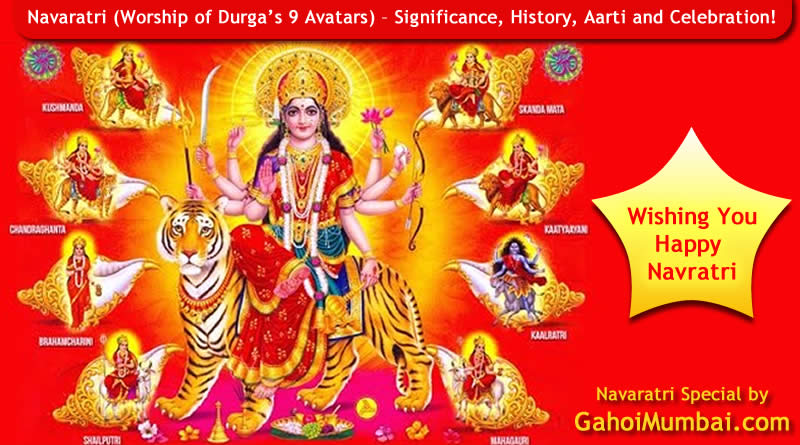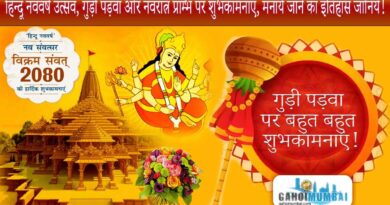Navaratri 2022 – Significance, History, Aarti and Celebration!
We all know that Navratri is a Hindu festival to worship goddess Durga’s 9 avatar to get blessings for our well-being and prosperity in terms of peace, good health, success, get rid from monetary problems, prosperity and resolving our kids’ issues. We celebrate Navratri for 9 days with fervour and enthusiasm. We also celebrate Navarati by wearing 9 different colours dresses to take blessings of Durga for 9 days. Each day belongs with specific colour to take blessings of Maa Durga for 9 days.
About Navaratri:
Navaratri – the word is a combination of two words – nava (meaning nine) and ratri (meaning night). i.e. Nine nights and is observed for nine days. Navaratri (Navratri or Navarathri) is a Hindu festival of Goddess Durga which is celebrated for ten days in the autumn (September, October) every year. Each of nine days signify one of the nine forms of Goddess Shakti: Durga, Bhadrakali, Jagadamba, Annapurna, Sarvamangala, Bhairavi, Chandika, Lalita, Bhavani and Mookambika. It is celebrated in different parts of India as well as abroad. Generally, there are four seasonal Navratri. It is observed that Sharada Navratri is celebrated in the honour of the divine feminine Devi Durga. The festival is celebrated in the bright half of the Hindu calendar month Ashvin, which typically falls in the Gregorian months of September and October. Sharad navratri dedicates three days each for the worship of three forms of Maa Shakti – Goddess Durga (first three days), Goddess Lakshmi (fourth to sixth day) and Goddess Saraswati (last three days).
Navaratri’s celebration time and date:
Generally, there are 4 types of Navaratri such as Sharada Navaratri (September-October), Vasanta Navaratri (March–April), Magha Navaratri (January–February) and Ashada Navaratri (June–July). Commonly, Sharada Navaratri is mostly celebrated Navaratri which falls in month of Ashvin (September-October). While Vasanta Navaratri is celebrated in month of Chaitra (post-winter, March–April).
This year Navadurga is celebrated from 26th September 2022 to 4th October 2022 with 9 colours for each day.
Navaratri 2022 Colours Pattern for Durga Maa Dresses and People:
Day 1: Ghatasthapna/Pratipada: (26 September 2022 – Monday) – White:
This is the day to worship Maa Shailaputri. The colour of the first day of Navaratri 2022 is White which is a symbol of inner peace, security and purity.
Navaratri colour 2022 Bollywood/South actresses in Navratri colour White:
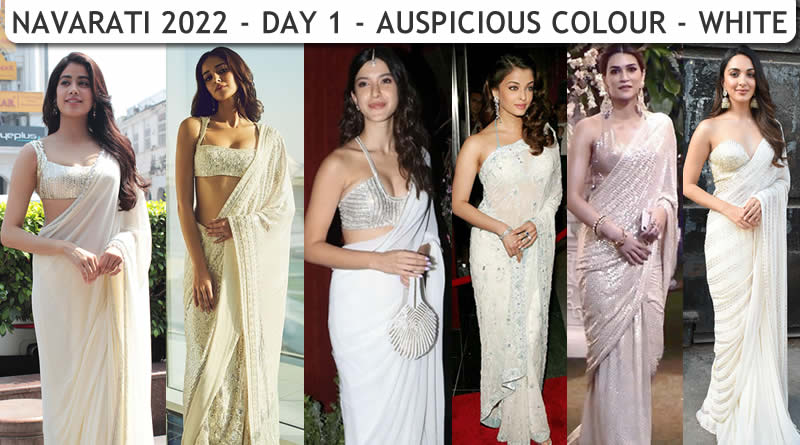


Day 2: Dwitiya (27 September 2022 – Tuesday) – Red
This is the day to worship Maa Brahmacharini. The colour of the second day of Navaratri 2022 is Red which is a symbol of beauty, fearlessness, love and passion. Vigour and vitality come from this red colour.
Navaratri colour 2022 Bollywood/South actresses Navratri colour Red:
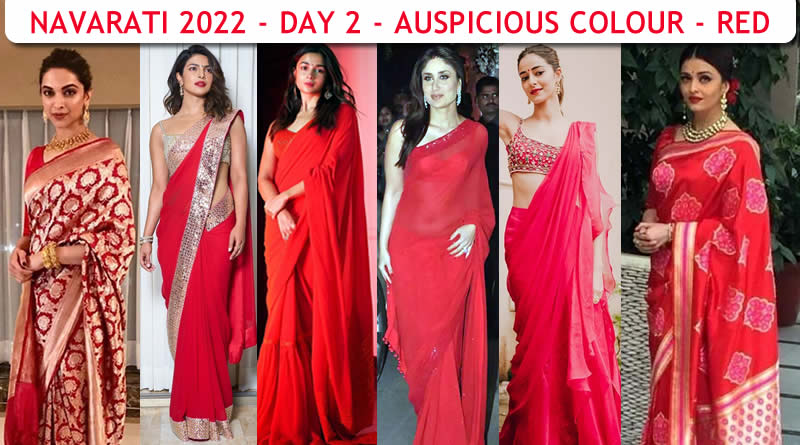
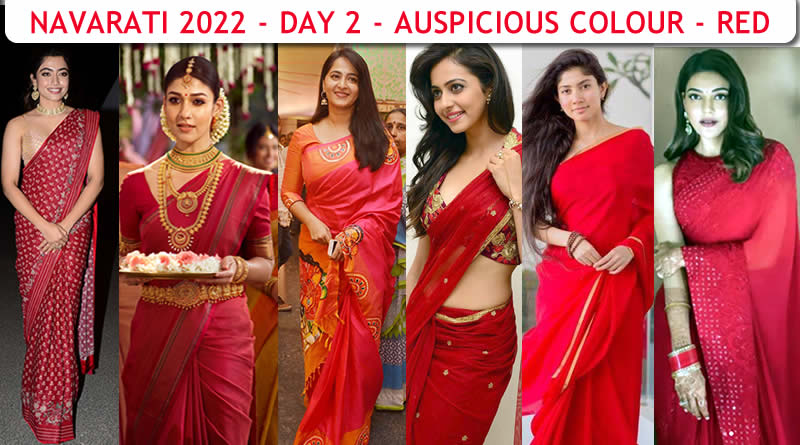
Day 3: Tritiya (28 September 2022 – Wednesday) – Royal Blue
This is the day to worship Maa Chandraghanta. The colour of the third day of Navaratri 2022 is Royal Blue which is a symbol of health, wealth, richness and tranquillity.
Navaratri colour 2022 Bollywood/south actresses Navratri colour Royal Blue:

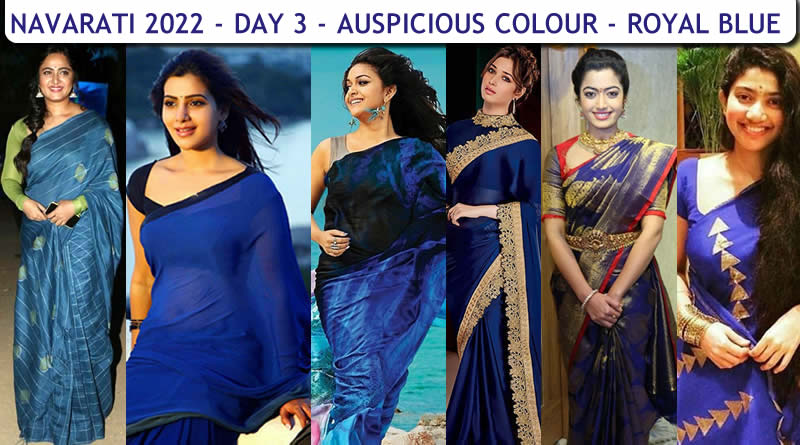
Day 4: Chaturthi (29 September 2022 – Thursday) – Yellow
This is the day to worship Maa Kushmanda. The colour of the fourth day of Navaratri 2022 is Yellow which is a symbol of happiness, brightness, warmness and cheerfulness.
Navaratri colour 2022 Bollywood/south actresses Navratri colour Yellow:

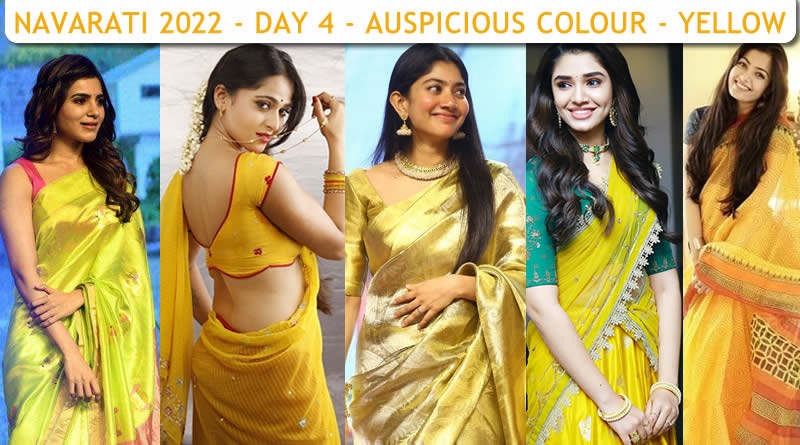
Day 5: Panchami (30 September 2022 – Friday) – Green
This is the day to worship Maa Skandmata. The colour of the fifth day of Navaratri 2022 is Green which is a symbol of new beginnings, growth, harmony and fresh energy into life.
Navaratri colour 2022 Bollywood/south actresses Navratri colour Green:
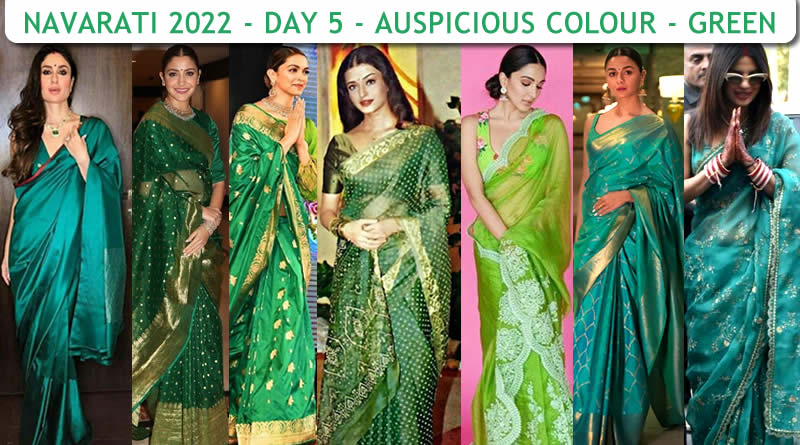
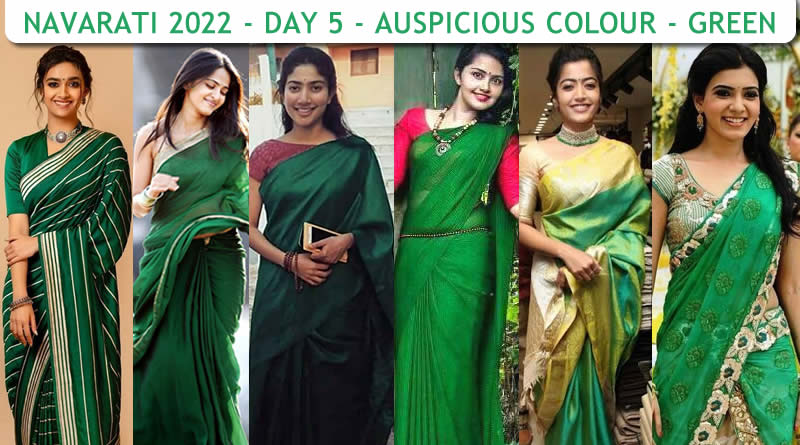
Day 6: Shasthi (1st October 2022 – Saturday) – Grey
This is the day to worship Maa Katyayani. The colour of the sixth day of Navaratri 2022 is Grey which is a symbol of zeal and determination to destroy evil. It stands for the strength of transforming.
Navaratri colour 2022 Bollywood/south actresses Navratri colour Grey:
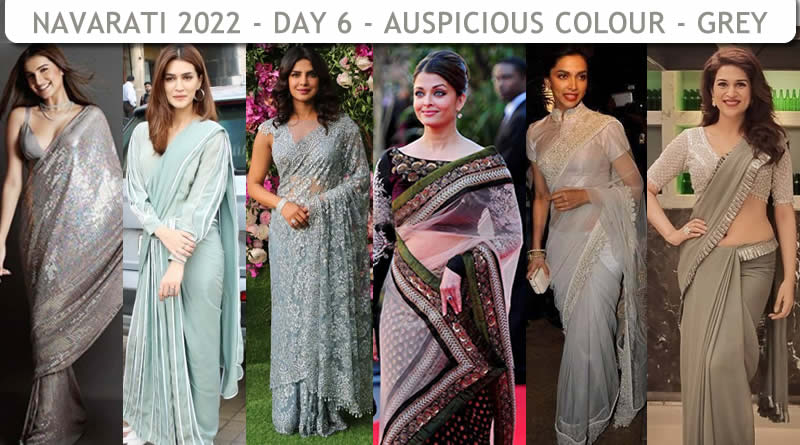
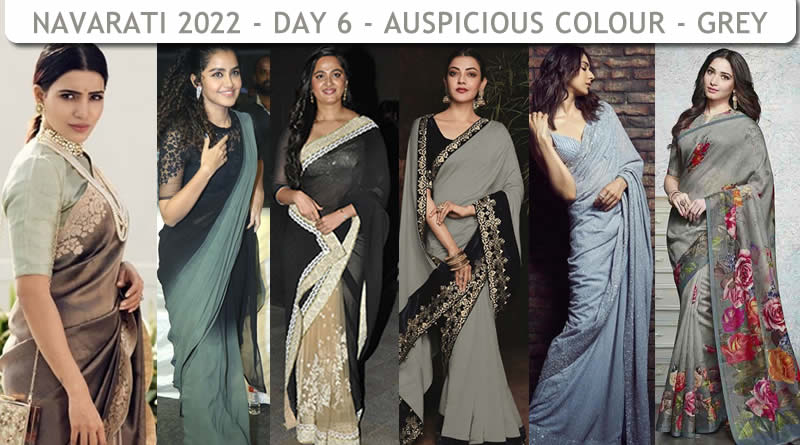
Day 7: Saptami (2nd October 2022 – Sunday) – Orange
This is the day to worship Maa Kaalratri. The colour of the seventh day of Navaratri 2022 is Orange which is a symbol of brightness, happiness and positive energy.
Navaratri colour 2022 Bollywood/south actresses Navratri colour Orange:
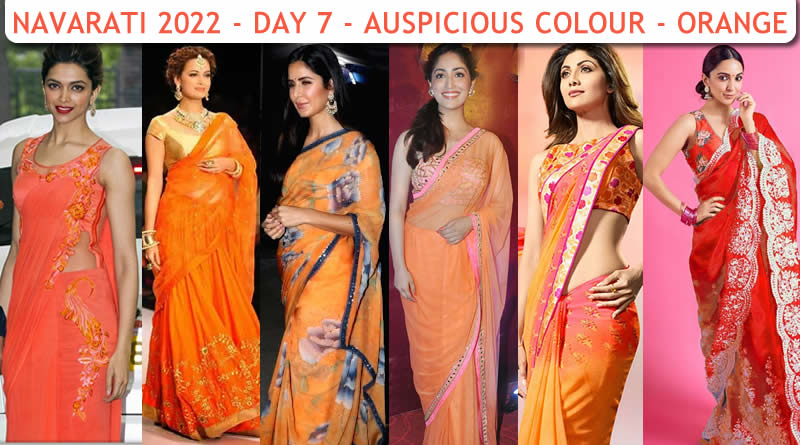

Day 8: Ashtami (3rd October 2022 – Monday) – Peacock Green
This is the day to worship Maa Mahagauri. The colour of the eight day of Navaratri 2022 is Peacock Green which is a symbol of compassion and freshness. It stands for glory, freedom, dignity, self-expression, love and aesthetics.
Navaratri colour 2022 Bollywood/south actresses Navratri colour Peacock Green:


Day 9: Navami (4th October 2022 – Tuesday) – Pink
This is the day to worship Maa Siddhidatri. The colour of the ninth day of Navaratri 2022 is Pink which is a symbol of hope, self-refinement and social upliftment.
Navaratri colour 2022 Bollywood/south actresses Navratri colour Pink:
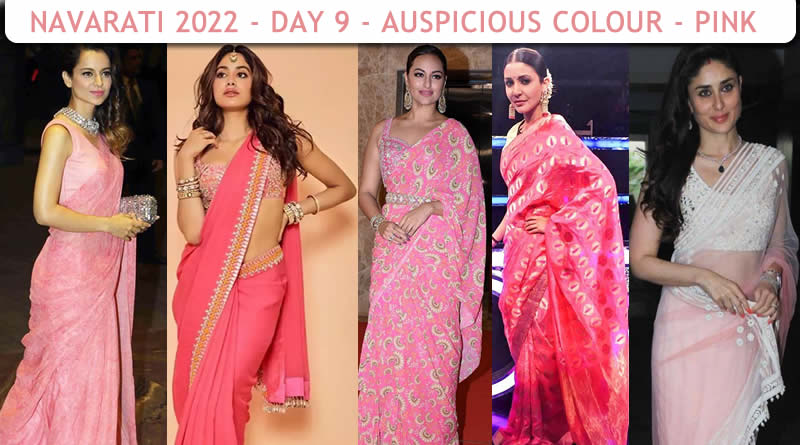
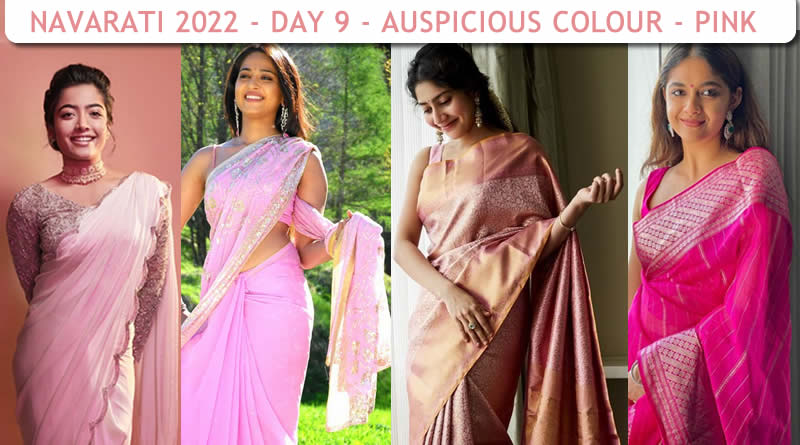
Myth and History of Navaratri Celebration:
As per celebration practices, In the eastern and north-eastern states of India, the Durga Puja is synonymous with Navratri, wherein goddess Durga fights and emerges victorious over the buffalo demon Mahishasura to help restore Dharmam. In the northern and western states, the festival is synonymous with “Rama Lila” and Dussehra that celebrates the battle and victory of God Rama over the demon king Ravana. In southern states, the victory of different goddesses, of Rama or Saraswati is celebrated. In all circumstances, the common cause is the battle and victory of Good over Evil based on a locally well-known epic or legend such as the Ramayana or the Devi Mahatmya.
Significance of Each Navaratri’s Day: These nine days are especially devoted to Goddess Durga and her Significance of Each Navaratri’s Day: nine Avatars. Each day is associated to an incarnation of the goddess.
Day 1: Shailaputri
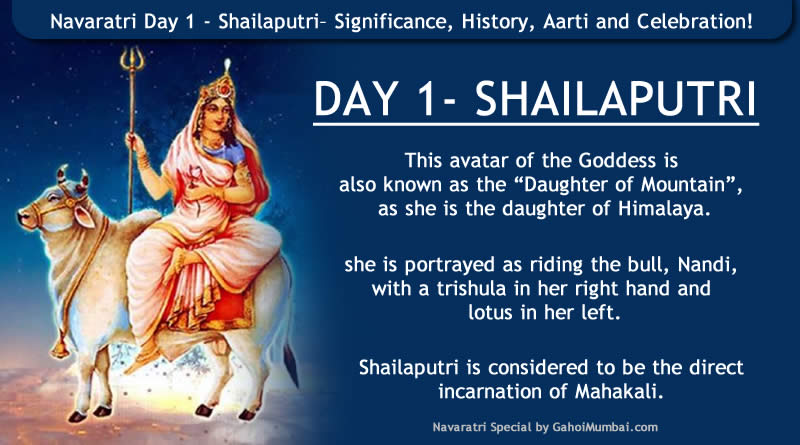
Navaratri Day 1 – Shailaputri– Significance, History, Aarti and Celebration!
First day is also known as Pratipada, this day is associated to Shailaputri (literally “Daughter of Mountain”), an incarnation of Parvati.
Myth about Shailaputri’s incarnation: This avatar of the Goddess is also known as the “Daughter of Mountain”, as she is the daughter of Himalaya. In her previous life, she was the daughter of King Daksha and wife of Lord Shiva. Hence, her name was Sati – Bhavani.
It happened that Daksha had organized a big yajna but he didn’t invite Lord Shiva. However, Sati attended the yajna. During the yajna, Daksha insulted Shiva. Unable to tolerate the insult, Sati sacrificed her life by burning herself in the fire of the yajna.
In her next life, Sati was born as the daughter of Himalaya and later on, she married Shiva. Her name was Parvati. According to the Upanishad, Parvati had even torn the egoism of Lord Indra and other gods.
It is in this form that the Goddess is worshiped as the consort of Shiva; she is portrayed as riding the bull, Nandi, with a trishula in her right hand and lotus in her left. Shailaputri is considered to be the direct incarnation of Mahakali.
Color of 1st Day: 1st day colour is WHITE, which is a symbol of peace and purity. Hindus worship Goddess Shailputri on this day. The festival of Navratri begins with the worship of the form of Goddess Durga, which is Mata Shailputri- the daughter of the mountains. If you want to get more blessing from the deity don a white colour attire on this day, which represents purity, peace and meditation. Shailputri symbolises Mother nature and her favourite flower is Jasmine.
Day 2: Brahmcharini

Navaratri Day 2 – Brahmcharini – Significance, History, Aarti and Celebration!
On second day (Dwitya), Goddess Brahmcharini, another incarnation of Parvati, is worshiped.
Durga, Brahmacharini is the second form. The word ‘Brahma” means “Tapa”.
The idol of this form of Durga has a rosary in her right hand. Portrayed as walking bare feet and holding a japamala and a kamandal is placed in her left hand. This form of Durga is known for her grace and it is considered as the symbol of cheerfulness, bliss and calm.
In this form, Parvati became Sati, her unmarried self. Brahmcharini is worshiped for emancipation or moksha and endowment of peace and prosperity.
Myth about Tapacharini” or Brahmacharini’s incarnation: In her earlier life, she was the daughter of Himvan and her name was Parvati.
One day, she was playing with her friends when Narad Muni came there and foretold that she would get wedded to a sadhu who had been her husband in her earlier life. Narad Muni also suggested that Goddess Durga should perform a penance for her would-be husband.
Parvati determined that she would wed none other than Shambhu or Lord Shiva. If this doesn’t happen, then she would not wed at all. Once she confirmed this, Parvati began observing penance. Hence she is referred as “Tapacharini” or “Brahmacharini”.
Color of 2nd Day: 2nd day colour is Red, which is a symbol of new beginnings and growth. The second day of Navratri is for the invocation of Goddess Brahmacharini. This day is devoted to the colour Red. This colour is associated with renewal, nature, and energy. Wearing this colour Red on the second day of Navrati brings growth, harmony and fresh energy into life. Along with this offer hibiscus flowers to the deity.
Day 3: Chandraghanta

Navaratri Day 3 – Chandraghanta – Significance, History, Aarti and Celebration!
Third day (Tritiya) observes the worship of Chandraghanta – the name derived from the fact that after marrying Shiva, Parvati adorned her forehead with half-chandra (half-moon).
Myth about Chandraghanta’s incarnation: Chandraghanta comes seated on a lion to fight the war with demons. She is a symbol of courage and bravery. Even the sound of her bell is something that the demons are afraid of.
This form of Goddess Durga has three eyes and ten hands. Around ten types of sword including weapons and arrows are placed in her hands.
She is the epitome of beauty and is also symbolic of bravery.
She is identified by the half-circular moon on her forehead.
Color of the 3rd day: 3rd day colour is Royal Blue. This colour is considered good for health and wealth. The third day is dedicated to the third form of Goddess Durga known as Mata Chandraghanta. The Devi carries the half-moon on her forehead and her favourite colour is Royal Blue. The Royal Blue colour associated with it symbolises immense power.
Day 4: Kushmunda
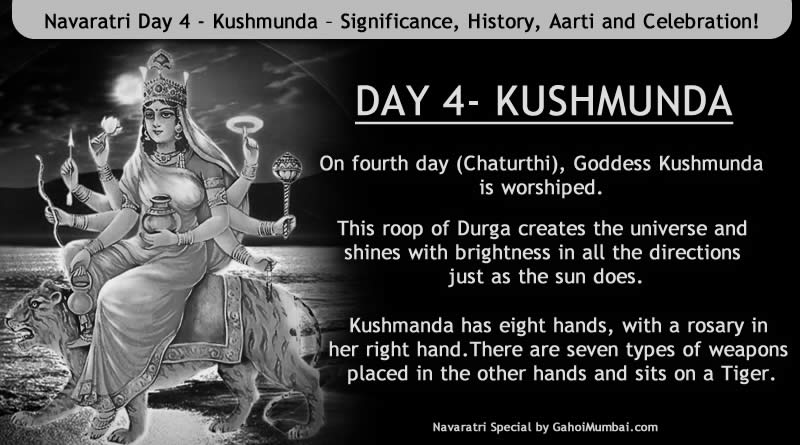
Navaratri Day 4 – Kushmunda – Significance, History, Aarti and Celebration!
On fourth day (Chaturthi), Goddess Kushmunda is worshiped. This is another Durga avatar whose residence is in the solar system is Kushmanda. Believed to be the creative power of universe.
Myth about Kushmunda’s incarnation: This roop of Durga creates the universe and shines with brightness in all the directions just as the sun does.
Kushmanda has eight hands, with a rosary in her right hand. There are seven types of weapons placed in the other hands.
She is depicted as having eight arms and sits on a Tiger.
She is pleased when the devotees make an offering of “Kumhde”. Henceforth, she is generally known as Kushmanda.
Color of the 4th day: 4th day colour is Yellow. The colour stands for happiness and brightness. Hindus worship Goddess Kushmanda on this day. The fourth day is dedicated to Goddess Khushmanda, Credited with creating the world with her divine smile. She is also referred to as the “smiling goddess”. The day is associated with yellow colour which is said to bring brightness, happiness, and cheer in our lives.
Day 5: Skandmata
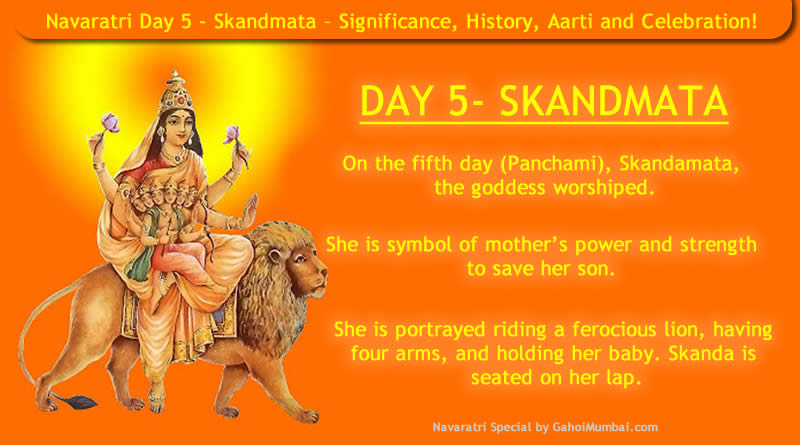
Navaratri Day 5 – Skandmata – Significance, History, Aarti and Celebration!
On the fifth day (Panchami), Skandamata, the goddess worshiped, who is the mother of Skand (or Kartikeya). She is symbol of mother’s power and strength to save her son.
Myth of the Skandmata’s incarnation: Skanda Mata got married to Shiva. They gave birth to a son named “Skanda”. The word “Skanda” means leader of the army of gods.
Skanda Mata is known as the deity of fire. The idol of Skanda Mata seated in a lotus comes with three eyes and four hands.
She is portrayed riding a ferocious lion, having four arms, and holding her baby. Skanda is seated on her lap.
Color of the 5th day: 5th day colour is GREEN, which is a symbol of new beginnings and growth. Hindus worship Goddess Skanda Mata on this day. Skandamata is the fifth form if of Goddess Durga that is seen holding Lord Kartikeya in her right arm. Worshipping this form of the Devi also gives the benefit of worshipping Lord Kartikeya. If you want to get more blessing from the deity don a green colour attire on this day, which represents growth, harmony and fresh energy into life. Along with this offer Jasmin flowers to the deity.
Day 6: Katyayani
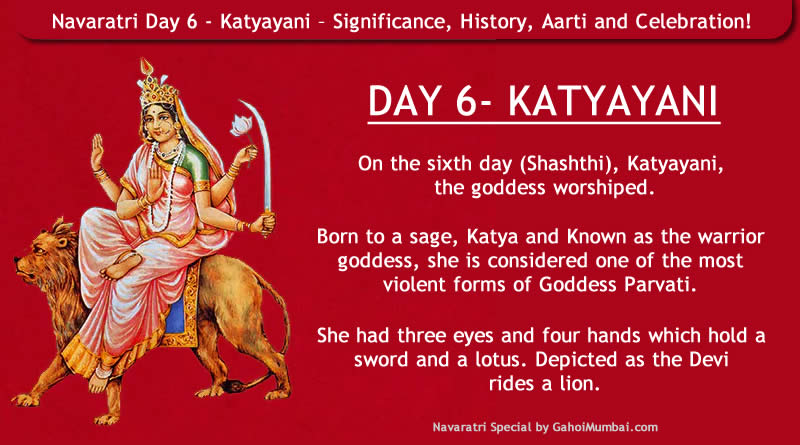
Navaratri Day 6 – Katyayani – Significance, History, Aarti and Celebration!
The sixth form of Durga is known as Katyayani. Born to a sage, Katya and Known as the warrior goddess, she is considered one of the most violent forms of Goddess Parvati.
Myth of the Katyayani’s incarnation: Rishi Katyayan observed penance so that he could become the father of Paramba. Finally, a daughter was born to him.
She was none other than Paramba. Katyayan named her Katyayani. She had three eyes and four hands which hold a sword and a lotus. Depicted as the Devi rides a lion.
Color of the 6th Day: Grey colour signifies the strength of transforming. Hindus worship Goddess Katyayani on this day. The sixth form of Goddess Durga is called Katyayani. She is the most powerful form of Goddess Durgaso as she is also hailed as the warrior-goddess or Bhadrakali. Being once of the fiercest form the Goddess Durga she is represented by the colour grey. Grey also symbolises zeal and determination to destroy evil.
Day 7: Kalratri
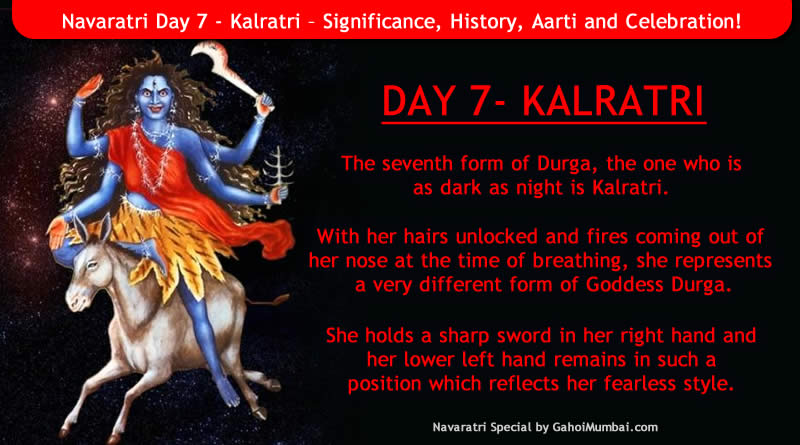
Navaratri Day 7 – Kalratri – Significance, History, Aarti and Celebration!
The seventh form of Durga, the one who is as dark as night is Kalratri. The most aggressive form of Goddess Durga, Kalaratri is worshiped on Saptmi.
Myth of the Kalratri’s incarnation: With her hairs unlocked and fires coming out of her nose at the time of breathing, she represents a very different form of Goddess Durga.
She had four hands. She holds a sharp sword in her right hand. On the left hand, she holds a burning torch; whereas, her lower left hand remains in such a position which reflects her fearless style. This form of Goddess Durga is known as “Shubhamkari”.
Color of the 7th day: The colour of the seventh day is Orange. This colour signifies energy and happiness. Hindus worship Goddess Kalratri on this day. Kalaratri is the seventh avatar of Navdurga. The word Kalaratri means the One who is “the Death of Kaal” and over here it is referred to as death. The Devi’s immense power is represented by the yellow colour. This colour represents brightness, happiness and positive energy.
Day 8: Mahagauri
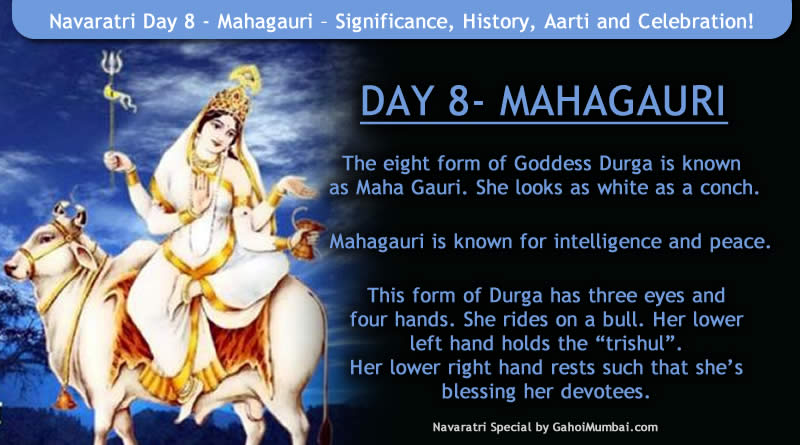
Navaratri Day 8 – Mahagauri – Significance, History, Aarti and Celebration!
The eight form of Goddess Durga is known as Maha Gauri. She looks as white as a conch. On eight day (Ashthami), Mahagauri is worshiped. Mahagauri is known for intelligence and peace.
Myth of Mahagauri’s incarnation: There goes a myth that Maha Gauri’s body became filthy due to dirt and dust, while she was observing penance. It was Lord Shiva who cleaned the body with the water of the Ganges. This made her body shine as bright as lightning. Hence, she is called “Maha Gauri”.
This form of Durga has three eyes and four hands. She rides on a bull. Her lower left hand holds the “trishul”. Her lower right hand rests such that she’s blessing her devotees. Her upper right hand holds a tambourine.
The color of the 8th Day: The colour of the 8th day is Peacock Green. This colour signifies the ‘desires and wishes that are fulfilled. People worship Goddess Mahagauri on this day. The eight-day is dedicated to Goddess Mahagauri. This form of Goddess Durga has the power to fulfil all the desires of her devotees. The one who worships this form of the Devi gets relief from all the sufferings in life. This day is associated with peacock green colour which represents glory, freedom, dignity, self-expression, love, and aesthetics.
Day 9: Sidhidatri

Navaratri Day 9 – Significance, History, Aarti and Celebration!
On the ninth day of the festival also known as Navami, people pray to Siddhidaatri (Ardanareeswara). Sitting on a lotus, she is believed to possess and bestows all type of Siddhis. Here she has four hands. Also known as Saraswati Devi.
Myth of Sidhidatri’s incarnation: This is the ninth avatar of Durga. There are in total eight siddhis. They are Anima, Mahima, Garima, Laghima, Prapti, Prakamya, Iishitva, and Vashitva.
As per Devipuran, Lord Shiva worshipped “Maha Shakti” or Siddhidatri and in return, got these Siddhis. Due to Maha Shakti’s blessings, half part of the body of Shiva look like the Goddess. Hence, he is also known as Ardhanarishvar.
Siddhidatri has four hands with holding a Shankh (Conch cell), a lotus and a Gada (mace), a Chakra and seated on lotus. This avatar of Durga is worshipped by all gods, saints, and yogis who’re willing to attain the highest spiritual strength.
Color of the 9th Day: 9th day colour Pink. The pink colour signifies the hope and fresh start. People worship Goddess Siddhidatri on this day. The last day of Navratri is all about worshipping Goddess Siddhidatri. It is made up of two words ‘Siddhi’ means supernatural power and ‘Dhatri’ means the awarder. This form of the Devi is a giver of knowledge and helps you achieve your aspirations. Hence, the day is associated with pink colour which represents hope, self-refinement and social upliftment.
How to celebrate Navaratri:
Navratri is celebrated in a different way in India’s various regions. Navaratri Celebrations include Devi Durga idol installation, stage decorations, recitation of the legend, enacting of the historical tale, and chanting of the scriptures of Hinduism. For numerous people it is a time of pious reflection and fasting; for others it is a time for dancing and feasting. The nine days are also a major crop season cultural event, such as competitive design and staging of pandals, a family visit to these pandals and the public celebration of classical and folk dances of Hindu culture. It also includes a strict vegetarian diet and abstaining from alcohol and certain spices during fasting. Dances performed include Garba, specifically in Gujarat and now it has spread all over India and Indian populated other countries. Generally the festival’s nine nights are devoted to different aspects of the divine feminine principle, or shakti. Normally, first third of the festival centers on aspects of the goddess Durga, the second third on the goddess Lakshmi, and the final third on the goddess Sarasvati. Kanya Pujan is very important aspect of Navaratri. Generally, Kanya Pujan takes place on the eighth or ninth day. In this ritual nine young girls are dressed as the nine goddess aspects celebrated during Navratri and are worshiped with ritual foot washing and given offerings such as food and clothing.
On the 10th day, called the Vijayadashami or Dussehra, the Durga Idols are either immersed in a water body such as river and ocean, or alternatively the statue symbolizing the evil such as Raavan is burnt with fireworks marking evil’s destruction. Dussehra is a time to celebrate the victories of good over evil, such as Durga’s victory over Mahishasura. In some parts of India, Dussehra is associated with the victory of the god Rama over the demon-king Ravana. In North India the Ram Lila (“Play of Rama”) is the highlight of the festival. Some celebrate by erecting bonfires and burning effigies of Ravana, sometimes by stuffing them with fireworks.
Navaratri Prayers:
Durga Stuti 1:
Sarva mangala mangalye shive sarvaartha saadhike
Sharanye trayambake Gauri
Narayani namosthute
Meaning:
sarva mangala mangalye– To auspiciousness of all auspiciousness
Shiva -to the Good
sarvarrtha saadhike – to the accomplisher of all objectives
sharanye – to the Source of Refuge
tryambake – to the mother of the three worlds.
Gauri – to the Goddess who is Rays of Light
Naaraayani – Exposer of consciousness
Namostute- We bow to you again and again. We worship you.
Durga Stuti 2:
Ya Devi Sarvbhuteshu matrarupen sansthitah
Ya Devi Sarvbhuteshu shaktirupen sansthitah
Ya Devi Sarvbhuteshu shantirupen sansthitah
Namastasyye Namastasyye Namastasyye Namo Namah
Om Ambaye Namah
या देवी सर्वभूतेषु मातृरुपेण संस्थितः ।
या देवी सर्वभूतेषु शक्तिरुपेण संस्थितः ।
या देवी सर्वभूतेषु शान्तिरुपेण संस्थितः ।
नमस्तस्यैः नमस्तस्यैः नमस्तस्यैः नमो नमः ।
ॐ अम्बायै नमः ॥
Meaning: Chanting Durga Stuti is alike to doing meditation. It gives a unique sense of satisfaction and one feels calm after chanting it. It also drive evil energies away from one’s life and attract positive energies. It helps a person grow healthy, wealthy and prosperous.
Navaratri Aarti:
Jai Ambe Gauri Arti:
Jai Ambe Gauri maiyaa, jai Shyaama Gauri
Nishdin tumko dhyaavat, Hari Brahmaa Shivji,
Jai Ambe Gauri maiyaa, jai Shyaama Gauri
Maang sindur biraajat, tiko mrigmadko,
Ujjvalse do naina, chandravadan niko,
Jai Ambe Gauri maiyaa, jai Shyaama Gauri
Kanak saman kalevar, raktaambar raje,
Raktapushp galmaala, kanthhaar saje,
Jai Ambe Gauri maiyaa, jai Shyaama Gauri
Kehari vaahan rajat, khadg khappar dhari
sur nar munijan sevat, tinke dukhahaari,
Jai Ambe Gauri maiyaa, jai Shyaama Gauri
Kaanan kundal shobhit, naasagre moti
Kotik chandra divaakar, samraajat jyoti,
Jai Ambe Gauri maiyaa, jai Shyaama Gauri
Shumbh- nishumbh vidaare, MahishaaSur ghatia
Dhumra-vilochan naina, nishdin madmati
Jai Ambe Gauri maiyaa, jai Shyaama Gauri
Brahmaani, Rudraani tum Kamalaa Raani,
Agam-nigam bakhaani. tum Shiv patraani,
Jai Ambe Gauri maiyaa, jai Shyaama Gauri
Chaunsath yogini gaavat, nritya karat Bhairon,
Baajat tab mridanga, aur bajat damru,
Jai Ambe Gauri maiyaa, jai Shyaama Gauri
Tum ho jag ki maataa, tum hi ho bhartaa,
Bhaktan ki dukh hartaa, sukh sampati kartaa,
Jai Ambe Gauri maiyaa, jai Shyaama Gauri
Bhujaa char ati shobhit, var mudraa dhaari,
Manvaanchhit phal paavat, sevak nar naari,
Jai Ambe Gauri maiyaa, jai Shyaama Gauri
Kanchan thaal virajat, agaru kapur baati
Malketu men rajat, kotiratan jyoti,
Jai Ambe Gauri maiyaa, jai Shyaama Gauri
Aadya Shakti Ma Arti:
Jaya aadya shakti, ma jaya aadya shakti
Akhand brhamand dipavya, panave pragatya ma
Om jayo jayo ma jagdambe
Dwitiya mehsarup shivshakti janu, ma shivshakti janu
Brahma ganapti gaye, brahma ganapti gaye
Hardayi har ma
Om jayo jayo ma jagdambe
Trutiya tran sarup tribhuvan ma betha, ma tribhuvan ma betha
Daya thaki karveli, daya thaki karveli
Utarvenima
Om jayo jayo ma jagdambe
Chouthe chatura malaxmi ma, sachrachal vyapya
Char bhuja cho disha, char bhuja cho disha
Pragtya dakshin ma
Om jayo jayo ma jagdambe
Panchame panchrushi panchami gunpadma, ma panchami gunpadma
Panchtatv tya soshiye, panchtatv tya soshiye
Panchetatvo ma
Om jayo jayo ma jagdambe
Shashthi tu narayani mahishasur maryo, ma mahishasur maryo
Narnari na rupe, narnari na rupe
Vyapaya saghale ma
Om jayo jayo ma jagdambe
Saptami sapt patal sandhya savitri, ma sandhya savitri
Gau ganga gayatri, gau ganga gayatri
Gauri geeta ma
Om jayo jayo ma jagdambe
Ashthmi ashtha bhujao ayi ananda, ma ayi ananda
Sunivar munivar janamya, sunivar munivar janamya
Dev daityoma
Om jayo jayo ma jagdambe
Navmi navkul nag seve navadurga, ma seve navadurga
Navratri na pujan, shivratri na archan
Kidha har brahma
Om jayo jayo ma jagdambe
Dashmi dash avtaar jay vijyalaxmi, ma jay vijyalaxmi
Rame ravan marya, rame ravan marya
Ravan maryo ma
Om jayo jayo ma jagdambe Ekadashi agiyar tatyanikama, ma tatyanikama Kaldurga kalika, kaldurga kalika Shama ne vama Om jayo jayo ma jagdambe
Barase kala rup bahuchar amba ma, ma bahuchar amba ma
Asur bhairav souie, kal bhairav soiye
Tara chhe tuj ma
Om jayo jayo ma jagdambe
Terase tulja rup tu tarunimata, ma tu tarunimata
Brahma vishnu sadashiv, brahma vishnu sadashiv
Gun tara gata
Om jayo jayo ma jagdambe
Shivbhakti ni aarati je koi gaye, ma je koi gaye
Bhane shivannad swami, bhane shivannad swami
Sukh sampati pashe,
Har kaileshe jashe
Ma amba dukh harashe
Om jayo jayo ma jagdambe
Nine Colors for the Navaratri and its importance:
As per tradition and beliefs, the dresses of the auspicious nine colors during nine days of navratri is helpful to get blessings from goddess Durga. Each color has different significance, which put different effect on people’s life. Please find here nine colors details here with their significance.
Royal Blue Colour: Royal blue colour represents strong energy and calmness. By wearing this colour if devotees worship goddess then Devi Durga will bless them with wealth and cheerfulness.
Yellow Colour: The yellow colour signifies happiness and brings hopefulness and self-assurance in life. During navratri, by wearing yellow outfits in the evening, if someone meditates then it helps in getting the positive energy.
Green Colour: Green colour signifies the success, unconditional love and wealth. This is the colour of nature, which is very calm and gentle. If believers wear green cloths in the evening and meditate then they can improve relationship.
Grey Colour: The grey color should be between black and white. This silver grey color shows the self-respect and connects you to divine power and provide you God protection. This color provides you knowledge to understand the hidden meaning of circumstances.
Orange Colour: This is the colour of recognition, name and wealth, which also enhance charm in your personality. Most of the yogis wear the saffron orange colors.
White Colour: This colour is the sign of peace, prayer, belief and strength. During navratri, the devotees who wear white cloths, Devi Maa purifies their mind and spirit. This colour gives graciousness and purity. Divine people normally wear white colour attire.
Red Colour: Red color is the sign of the power, passion and fervor. This is the goddess’s favourite color. In most the depictions, Devi Maa can be seen in the red saari and red kumkum. Devotees should offer red roses to the deity on this day.
Sky Blue Colour: Sky blue colour signifies vastness and belief. Light blue colour depicts respect towards nature’s beauty. This colour helps you in attaining the spiritual power. People should wear sky blue cloths and meditate in the morning to get the blessings of goddess.
Pink Colour: The pink colour signifies the hope and fresh start. The devotees, who wear pink colour cloths and worship goddess then goddess will bless them and abolish all the sins.
Navaratri Garba or Dandia – a devotional dance form:
Navaratri Garba or Dandia is a form of devotional dance which is generally practiced to please goddess Durga during Navaratri. Navaratri is a nine-day festival devoted to Goddess Shakti. The Dandiya dance is the most famous among the youth for it holds a special significance in the Navaratris. It is the depiction of a mock fight between the Goddess and Mahishasura – the mighty demon-king. The sticks of the dance signify the sword of Durga. Usually women perform the dance as they move around the ‘mandvi’. As per the ritual, Dandia Raas is performed after the Arti i.e. worshipping the deity Durga. Generally, women wear enlarged long skirts (ghagharas) and cholis, with their head covered with odhaani; while the men wears kediyum (shirt) and vajani (trouser) with a printed scarf on their head.
Navaratri Special Bollywood Songs: We are giving a list of Bollywood’s a few songs for Navaratri and doing Garba and Dandia.
- Shubhaarambh! (Film Kai Po Che!)
- Dholi Tharo Dhol Baje! (Film Hum Dil De Chuke Sanam)
- Nagada Sang Dhol Baaje! (Goliyon Ki Raasleela Ram-Leela)
- Dola Re! (Film Devdas)
- Radha Kaise Na Jale (Film Lagaan)
- Udi Udi Jaye (Film Raees)
- Gunji Aangna Mein Shehnai (Film Life Partner)
- Lahu Munh Lag Gaya (Film Goliyon Ki Raasleela Ram-Leela)
- Rangilo Maro Dholna (Music Album Pyar Ke Geet)
- Saason Ki Zarurat Hai Jaise (Film Rock On!)
- O Sheronwali (Film Suhaag)
- Maine Payal Hai Chhankai (Falguni Pathak)
- Meri Chunar Udd Udd Jaye (Falguni Pathak)
- O Piya (Falguni Pathak)
- Indhana Winva (Falguni Pathak)
- Aiyo Rama (Falguni Pathak)
- Pankhida Tu Udi Jaje (Falguni Pathak)
- Chogada (Film Loveyatri)
- Kamariya (Film Mitron)
- Sanedo (Film Mitron)
- Rangtaari (Film Loveyatri)

